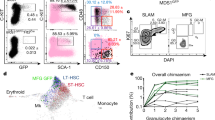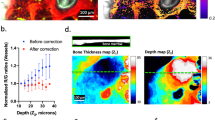Abstract
Haematopoietic stem cell (HSC) niches, although proposed decades ago1, have only recently been identified as separate osteoblastic and vascular microenvironments2,3,4,5,6. Their interrelationships and interactions with HSCs in vivo remain largely unknown. Here we report the use of a newly developed ex vivo real-time imaging technology and immunoassaying to trace the homing of purified green-fluorescent-protein-expressing (GFP+) HSCs. We found that transplanted HSCs tended to home to the endosteum (an inner bone surface) in irradiated mice, but were randomly distributed and unstable in non-irradiated mice. Moreover, GFP+ HSCs were more frequently detected in the trabecular bone area compared with compact bone area, and this was validated by live imaging bioluminescence driven by the stem-cell-leukaemia (Scl) promoter–enhancer7. HSCs home to bone marrow through the vascular system. We found that the endosteum is well vascularized and that vasculature is frequently localized near N-cadherin+ pre-osteoblastic cells, a known niche component. By monitoring individual HSC behaviour using real-time imaging, we found that a portion of the homed HSCs underwent active division in the irradiated mice, coinciding with their expansion as measured by flow assay. Thus, in contrast to central marrow, the endosteum formed a special zone, which normally maintains HSCs but promotes their expansion in response to bone marrow damage.
This is a preview of subscription content, access via your institution
Access options
Subscribe to this journal
Receive 51 print issues and online access
$199.00 per year
only $3.90 per issue
Buy this article
- Purchase on Springer Link
- Instant access to full article PDF
Prices may be subject to local taxes which are calculated during checkout




Similar content being viewed by others
References
Schofield, R. The relationship between the spleen colony-forming cell and the haemopoietic stem cell. Blood Cells 4, 7–25 (1978)
Zhang, J. et al. Identification of the haematopoietic stem cell niche and control of the niche size. Nature 425, 836–841 (2003)
Calvi, L. M. et al. Osteoblastic cells regulate the haematopoietic stem cell niche. Nature 425, 841–846 (2003)
Nilsson, S. K., Johnston, H. M. & Coverdale, J. A. Spatial localization of transplanted hemopoietic stem cells: inferences for the localization of stem cell niches. Blood 97, 2293–2299 (2001)
Arai, F. et al. Tie2/angiopoietin-1 signaling regulates hematopoietic stem cell quiescence in the bone marrow niche. Cell 118, 149–161 (2004)
Kiel, M. J., Yilmaz, O. H., Iwashita, T., Terhorst, C. & Morrison, S. J. SLAM family receptors distinguish hematopoietic stem and progenitor cells and reveal endothelial niches for stem cells. Cell 121, 1109–1121 (2005)
Murphy, G. J. et al. Manipulation of mouse hematopoietic progenitors by specific retroviral infection. J. Biol. Chem. 278, 43556–43563 (2003)
Schroeder, T. Imaging stem-cell-driven regeneration in mammals. Nature 453, 345–351 (2008)
Christensen, J. L. & Weissman, I. L. Flk-2 is a marker in hematopoietic stem cell differentiation: a simple method to isolate long-term stem cells. Proc. Natl Acad. Sci. USA 98, 14541–14546 (2001)
Juopperi, T. A. et al. Isolation of bone marrow-derived stem cells using density-gradient separation. Exp. Hematol. 35, 335–341 (2007)
Denk, W., Strickler, J. H. & Webb, W. W. Two-photon laser scanning fluorescence microscopy. Science. 248, 73–76 (1990)
König, K. Multiphoton microscopy in life sciences. J. Microsc. 200, 83–104 (2000)
Zhang, J. et al. PTEN maintains haematopoietic stem cells and acts in lineage choice and leukaemia prevention. Nature 441, 518–522 (2006)
Adams, G. B. et al. Stem cell engraftment at the endosteal niche is specified by the calcium-sensing receptor. Nature 439, 599–603 (2006)
Jung, Y. et al. Regulation of SDF-1 (CXCL12) production by osteoblasts; a possible mechanism for stem cell homing. Bone 38, 497–508 (2006)
Gothert, J. R. et al. In vivo fate-tracing studies using the Scl stem cell enhancer: embryonic hematopoietic stem cells significantly contribute to adult hematopoiesis. Blood 105, 2724–2732 (2005)
Chen, C. Z. et al. Identification of endoglin as a functional marker that defines long-term repopulating hematopoietic stem cells. Proc. Natl Acad. Sci. USA 99, 15468–15473 (2002)
Sausville, J. et al. RCAS/SCL-TVA animal model allows targeted delivery of polyoma middle T oncogene to vascular endothelial progenitors in vivo and results in hemangioma development. Clin. Cancer Res. 14, 3948–3955 (2008)
Kopp, H. G., Avecilla, S. T., Hooper, A. T. & Rafii, S. The bone marrow vascular niche: home of HSC differentiation and mobilization. Physiology 20, 349–356 (2005)
Haug, J. S. et al. N-cadherin expression level distinguishes reserved versus primed states of hematopoietic stem cells. Cell Stem Cell 2, 367–379 (2008)
Luo, Y., Kostetskii, I. & Radice, G. L. N-cadherin is not essential for limb mesenchymal chondrogenesis. Dev. Dyn. 232, 336–344 (2005)
Kalajzic, I. et al. Use of type I collagen green fluorescent protein transgenes to identify subpopulations of cells at different stages of the osteoblast lineage. J. Bone Miner. Res. 17, 15–25 (2002)
Nakashima, K. et al. The novel zinc finger-containing transcription factor osterix is required for osteoblast differentiation and bone formation. Cell 108, 17–29 (2002)
Balazs, A. B., Fabian, A. J., Esmon, C. T. & Mulligan, R. C. Endothelial protein C receptor (CD201) explicitly identifies hematopoietic stem cells in murine bone marrow. Blood 107, 2317–2321 (2006)
Osawa, M. et al. In vivo self-renewal of c-Kit+ Sca-1+ Lin(low/-) hemopoietic stem cells. J. Immunol. 156, 3207–3214 (1996)
Nilsson, S. K. et al. Osteopontin, a key component of the hematopoietic stem cell niche and regulator of primitive hematopoietic progenitor cells. Blood 106, 1232–1239 (2005)
Mayack, S. R. & Wagers, A. J. Osteolineage niche cells initiate hematopoietic stem cell mobilization. Blood 112, 519–531 (2008)
Kollet, O. et al. Osteoclasts degrade endosteal components and promote mobilization of hematopoietic progenitor cells. Nature Med. 12, 657–664 (2006)
Sugiyama, T., Kohara, H., Noda, M. & Nagasawa, T. Maintenance of the hematopoietic stem cell pool by CXCL12-CXCR4 chemokine signaling in bone marrow stromal cell niches. Immunity 25, 977–988 (2006)
Katayama, Y. et al. Signals from the sympathetic nervous system regulate hematopoietic stem cell egress from bone marrow. Cell 124, 407–421 (2006)
Acknowledgements
We appreciate scientific support from R. Krumlauf, W. Neaves and encouragement from G. Lu and W. Shen. We are grateful to D. Scadden and P. Kulesa for discussion. We thank D. Rowe for providing the Col2.3-GFP line. We thank R. Yu, L. Ma, Q. Qiu and W. Wang for technological advice, M. Hembree, A. Box, H. Marshall, E. Rendenbaugh, C. Cooper and M. Smith for technical support, S. Beckham for histology assistance, J. Perry and J. Ross for comments, and K. Tannen for proofreading. R.A.F. was supported by DOD grant W81XWH-04-1-0801 and by a DRIF Award from the University of Maryland. L.L. is supported by Stowers Institute for Medical Research.
Author Contributions Y.X. and T.Y. developed the initial idea, designed and performed experiments. W.W. contributed to EVISC instrumentation and real-time imaging. X.C.H. helped on data analysis, troubleshooting and immunostaining for Ncad LacZ. D.S. assisted in real-time imaging. J.P., J.H., J.W., T.J. and S.Z. assisted in some experiments. J.S., K.P. and R.A. performed quantification of fluorescent intensity. H.L. contributed to statistics. D.M. and R.A.F. contributed to bioluminescent imaging. J.G. assisted in data analysis and manuscript writing. L.L. contributed to overall supervision, experimental design and manuscript writing.
Author information
Authors and Affiliations
Corresponding authors
Supplementary information
Supplementary Information
This file contains Supplementary Figures 1-6, Supplementary Tables I-VIII and Descriptions of Supplementary Movies 1-8. An error in the titles of Supplementary Movies 2 and 3 was corrected on 06 January 2009 (PDF 6366 kb)
Supplementary Movie 1
Supplementary Movie 1. Real-time imaging of bone marrow cells in the trabecular bone area of GFP-tg mice. (MOV 6584 kb)
Supplementary Movie 2
Supplementary Movie 2. A homed (under irradiated conditions) GFP-HSC at the endosteal surface. (MOV 735 kb)
Supplementary Movie 3
Supplementary Movie 3. A homed (under non-irradiated conditions) GFP-HSC at the central marrow region. (MOV 1101 kb)
Supplementary Movie 4
Supplementary Movie 4. This movie seems to show (with speculation) how cells derived from bone marrow (stromal cells?) were received by large cells that located on the bone surface, and were placed on the bone surface. (MOV 460 kb)
Supplementary Movie 5
Supplementary Movie 5. Three-dimensional view of a homed GFP-HSC attaching to an N-cadherin+ osteoblast. (MOV 1390 kb)
Supplementary Movie 6
Supplementary Movie 6. A homed GFP-HSC located at the tip of a nook structure formed between two bone structures (revealed by DIC). (MOV 2245 kb)
Supplementary Movie 7
Supplementary Movie 7. (MOV 3946 kb)
Supplementary Movie 8
Supplementary Movie 8. (MOV 9378 kb)
Rights and permissions
About this article
Cite this article
Xie, Y., Yin, T., Wiegraebe, W. et al. Detection of functional haematopoietic stem cell niche using real-time imaging. Nature 457, 97–101 (2009). https://doi.org/10.1038/nature07639
Received:
Accepted:
Published:
Issue Date:
DOI: https://doi.org/10.1038/nature07639
This article is cited by
-
Crosstalk between DNA methylation and hypoxia in acute myeloid leukaemia
Clinical Epigenetics (2023)
-
Minimally invasive longitudinal intravital imaging of cellular dynamics in intact long bone
Nature Protocols (2023)
-
The universal stem cell
Leukemia (2022)
-
Cholinergic signals preserve haematopoietic stem cell quiescence during regenerative haematopoiesis
Nature Communications (2022)
-
Multienzymes activity of metals and metal oxide nanomaterials: applications from biotechnology to medicine and environmental engineering
Journal of Nanobiotechnology (2021)
Comments
By submitting a comment you agree to abide by our Terms and Community Guidelines. If you find something abusive or that does not comply with our terms or guidelines please flag it as inappropriate.



